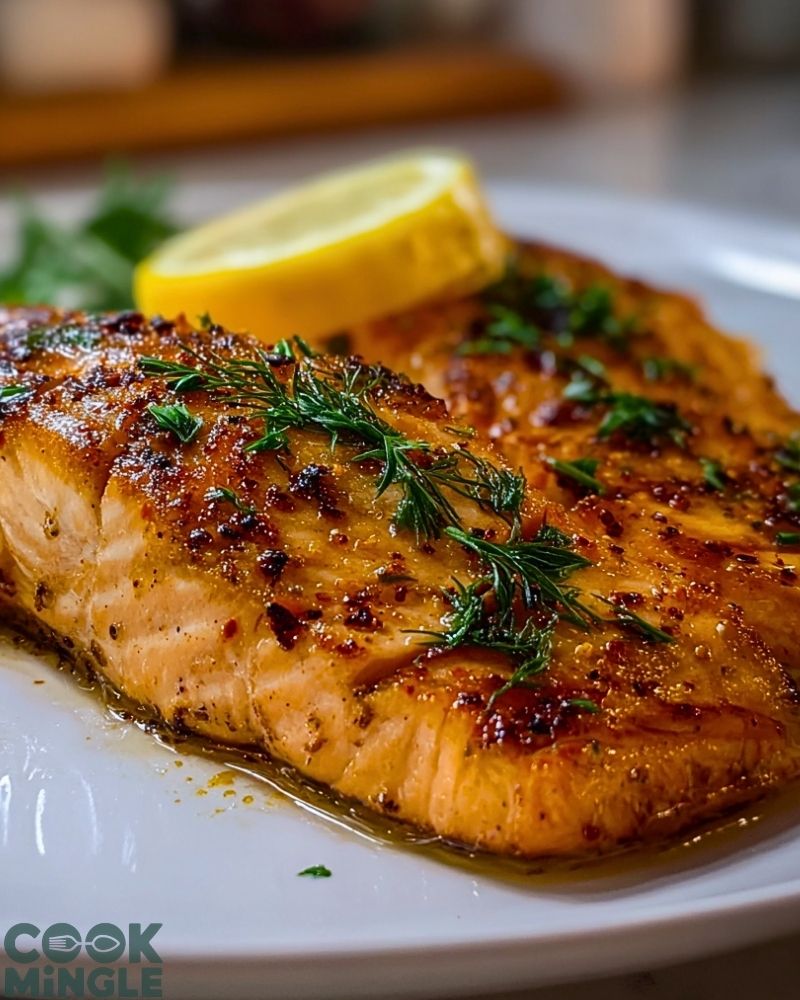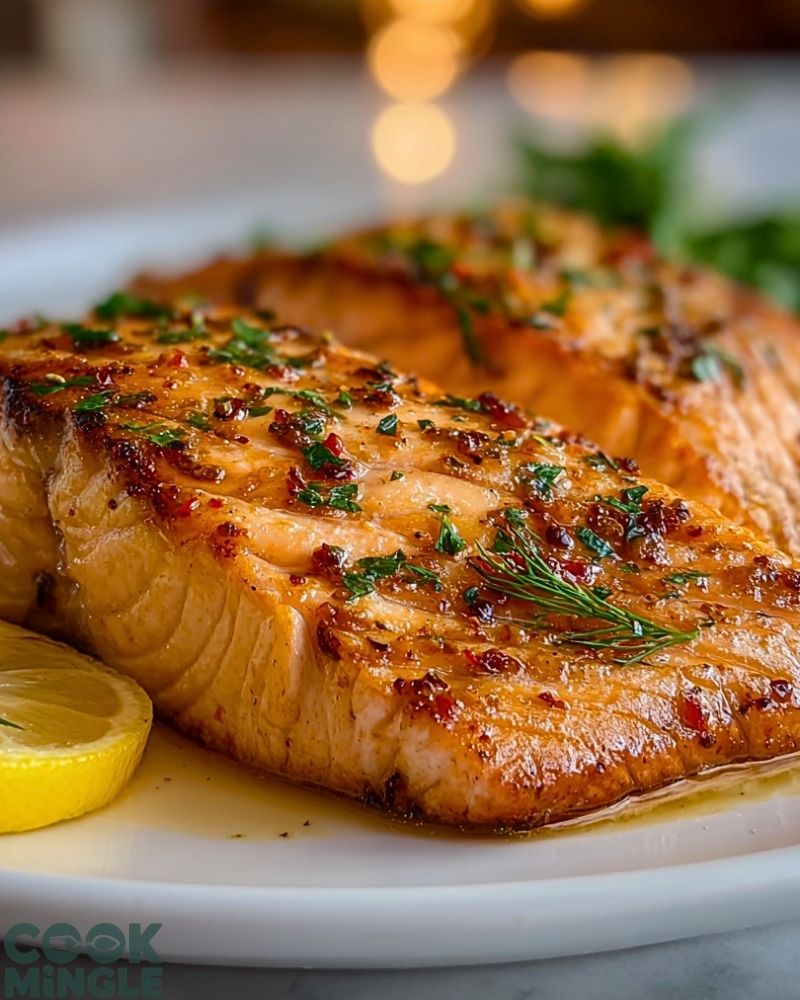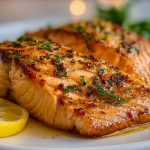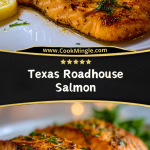Texas Roadhouse Salmon is a dish that delivers on both bold flavor and effortless elegance. Featuring perfectly seasoned, pan-seared fillets with a caramelized crust and juicy, flaky center, this salmon recipe mirrors the mouthwatering version served at the famous steakhouse. Finished with a squeeze of fresh lemon and garnished with a touch of dill or parsley, it’s as visually appealing as it is delicious.

This recipe strikes the perfect balance between smoky, savory spices and the natural richness of the salmon. Whether you’re looking for a quick weekday dinner or a refined meal for entertaining, this dish offers a restaurant-quality experience made in your own kitchen. Pair it with your favorite sides, and you’ve got an unforgettable plate that’s as healthy as it is hearty.
Why You’ll Love This Texas Roadhouse Salmon
- Restaurant Flavor at Home: Capture that signature steakhouse taste with pantry spices and a hot skillet.
- Quick to Make: Ready in under 30 minutes from prep to plate.
- Versatile: Works well with various sides like baked potatoes, steamed veggies, or a fresh garden salad.
- Healthy: High in omega-3s and protein without being heavy or greasy.
- Crowd-Pleaser: Impress guests with a beautiful, flavorful entrée that requires minimal effort.
Preparation Phase & Tools to Use (Essential Tools and the Importance of Each)
Before you start cooking your Texas Roadhouse Salmon, take a few minutes to set up your kitchen for success. The right tools can make the difference between a good salmon fillet and a restaurant-worthy one.
- Cast Iron Skillet or Heavy-Bottomed Pan: Essential for achieving that signature sear and caramelized crust. Cast iron holds and distributes heat evenly, which helps in getting that golden exterior without overcooking the interior.
- Fish Spatula: This thin, flexible tool helps you flip the salmon without tearing the delicate flesh.
- Instant-Read Thermometer: Ensures your salmon reaches the perfect internal temperature (125–130°F for medium) without guessing.
- Mixing Bowl: Needed for combining your spice rub evenly.
- Tongs: Handy for moving the salmon around in the pan gently and safely.
- Paper Towels: To pat the salmon dry—this step is critical to achieving that crusty finish.
Preparation Tips
- Pat the Salmon Dry: Moisture is the enemy of a good sear. Blot the salmon fillets thoroughly with paper towels before seasoning.
- Bring to Room Temperature: Let the salmon sit out for 15–20 minutes before cooking to ensure even heat distribution.
- Preheat the Pan: Don’t add the salmon to a cold pan. Let your skillet get hot enough that a drop of water sizzles instantly—this ensures proper browning.
- Don’t Overcrowd the Pan: Cook in batches if needed. Overcrowding traps steam and prevents searing.
- Use Neutral Oil with High Smoke Point: Avocado or canola oil works great. Avoid olive oil—it may burn at high temperatures.
- Let It Rest: After cooking, rest the fillets for 3–5 minutes to allow juices to redistribute for a moist interior.
Ingredients for This Texas Roadhouse Salmon
Here’s everything you’ll need to recreate this juicy, flavor-packed salmon dish at home. The ingredients are simple, yet when combined, they bring out the richness and smokiness that define Texas Roadhouse-style cooking.
For the Salmon:
- 4 salmon fillets (6 oz each, skinless or skin-on)
- 2 tablespoons olive oil or avocado oil
- Salt and black pepper, to taste
- 1 lemon (half sliced, half juiced)
- Fresh dill or parsley, for garnish (optional)
For the Texas-Style Spice Rub:
- 1 tablespoon brown sugar
- 1 teaspoon smoked paprika
- 1 teaspoon garlic powder
- 1 teaspoon onion powder
- ½ teaspoon cayenne pepper (adjust to heat preference)
- ½ teaspoon dried thyme
- ½ teaspoon dried oregano
- ¼ teaspoon crushed red pepper flakes (optional, for added kick)
Tip: Mix the rub ingredients in advance and store in an airtight jar—it doubles as a great all-purpose seasoning.

Step 1: Prepare the Spice Rub
In a small bowl, combine the brown sugar, smoked paprika, garlic powder, onion powder, cayenne pepper, thyme, oregano, and red pepper flakes. Mix well until evenly blended. Set aside.
Step 2: Prep the Salmon
Pat the salmon fillets dry with paper towels. This helps the spice rub stick and allows the surface to sear properly. Lightly season both sides of each fillet with salt and black pepper.
Step 3: Apply the Rub
Generously coat the top of each fillet with the spice rub, pressing it gently into the flesh so it adheres. Let the fillets sit for 10 minutes to allow the seasoning to soak in.
Step 4: Heat the Skillet
Place a cast iron or heavy-bottomed skillet over medium-high heat. Once hot, add the olive oil. Swirl to coat the pan evenly.
Step 5: Cook the Salmon
Place the salmon fillets spice-side down into the hot skillet. Sear for about 3–4 minutes until a golden crust forms. Flip gently with a fish spatula and cook for another 3–4 minutes or until the salmon reaches an internal temperature of 125–130°F (for medium doneness).
Step 6: Add Lemon Juice and Rest
Squeeze fresh lemon juice over the salmon while still in the pan. Remove the fillets and let them rest on a plate for 3–5 minutes. Garnish with fresh dill or parsley and add lemon slices if desired.
Notes
- Skin-On vs. Skinless: If using skin-on fillets, cook skin-side down first to crisp it up. It also helps hold the fish together.
- Spice Level: Adjust cayenne and red pepper flakes to match your preferred heat. You can omit them entirely for a milder dish.
- Sugar in the Rub: Brown sugar adds a subtle sweetness and helps caramelize the crust, but don’t let it burn—keep an eye on the heat.
- Oil Choice: Avocado oil is ideal due to its high smoke point and neutral flavor.
- Leftover Rub: Store any extra spice mix in a sealed jar and use it on chicken, shrimp, or vegetables.
Watch Out for These Mistakes While Cooking
- Cooking Cold Fish: Don’t place fridge-cold salmon directly in the pan. This leads to uneven cooking and can make the center raw.
- Skipping the Drying Step: Moisture on the salmon’s surface prevents proper searing and causes steaming.
- Overcrowding the Pan: Cooking too many fillets at once will reduce heat and result in a pale, soggy exterior.
- Overcooking: Salmon cooks fast—go by temperature, not time. Remove from heat at 125°F; residual heat will finish the job.
- Using Low Heat: You won’t get that signature Texas Roadhouse-style crust unless the pan is hot enough.
- Forgetting to Rest: Cutting too soon releases all the juices—give it a short rest to lock in moisture.
- Using Butter Alone: While tasty, butter burns quickly. Combine with oil or add it at the end for flavor.
- Not Seasoning Enough: Be generous with the rub. It’s where most of the flavor lives!
What to Serve With Texas Roadhouse Salmon?
The bold, smoky flavors of this salmon pair beautifully with a variety of classic sides—from hearty comfort foods to light, refreshing vegetables. Choose one or mix a few to round out your meal.
8 Recommendations
- Garlic Mashed Potatoes
Creamy, buttery, and full of roasted garlic flavor—this is the ultimate sidekick for salmon. - Seasoned Rice Pilaf
A light, herby rice dish that soaks up the lemony salmon juices beautifully. - Steamed Broccoli with Lemon Zest
Keeps the meal healthy and adds a nice crunch with minimal effort. - Sweet Glazed Carrots
Their natural sweetness contrasts well with the spice rub on the salmon. - Caesar Salad
Crisp romaine with tangy dressing adds a cooling balance to the warm, bold fish. - Baked Sweet Potato
A nod to Texas Roadhouse’s menu—with cinnamon butter if you want the real deal. - Grilled Asparagus
Earthy and slightly charred, asparagus complements the smoky notes of the salmon. - Buttered Corn on the Cob
Sweet and juicy with just enough richness to round out a steakhouse-style plate.
Storage Instructions
To keep your Texas Roadhouse Salmon tasting fresh, proper storage is key:
- Refrigerator: Store cooked salmon in an airtight container. It will stay fresh for up to 3 days.
- Freezer: Wrap cooled fillets tightly in plastic wrap, then foil, or place in a freezer-safe bag. Freeze for up to 2 months.
- Reheating: For best results, reheat in a skillet over low heat or in a 300°F oven for 10–12 minutes. Avoid the microwave—it tends to dry out the fish.
- Tip: Add a splash of lemon juice or a pat of butter while reheating to restore moisture and flavor.
Estimated Nutrition (Per 6 oz fillet with rub, without sides)
- Calories: 310
- Protein: 34g
- Total Fat: 18g
- Saturated Fat: 3g
- Unsaturated Fat: 13g
- Trans Fat: 0g
- Cholesterol: 80mg
- Carbohydrates: 4g
- Sugar: 2g
- Fiber: 1g
- Sodium: 320mg
Values are approximate and may vary based on the size of the salmon fillet and exact ingredients used.
Frequently Asked Questions
1. Can I use frozen salmon for this recipe?
Yes, just make sure it’s completely thawed and patted dry before applying the rub and cooking.
2. Is this dish spicy?
It has a mild to moderate kick due to cayenne and red pepper flakes, but you can easily adjust or omit those for a milder flavor.
3. Can I grill the salmon instead of pan-searing it?
Absolutely. Just oil the grill grates well and cook over medium-high heat for 3–4 minutes per side.
4. What type of salmon works best?
Atlantic salmon is widely available and has a rich flavor, but wild-caught sockeye or coho offer a firmer texture and deeper taste.
5. Do I need to marinate the salmon?
No marinade is required—the spice rub delivers plenty of flavor. A short rest with the rub before cooking is all it needs.
6. How do I know when the salmon is done?
Use a thermometer to check for 125–130°F internal temperature. The flesh should flake easily with a fork and look opaque in the center.
7. Is this dish gluten-free?
Yes, this recipe is naturally gluten-free as long as all seasoning ingredients are certified gluten-free.
8. Can I make this ahead of time?
You can prepare the spice rub and season the salmon ahead of time, but for best texture, cook it fresh right before serving.
Conclusion
Texas Roadhouse Salmon brings bold flavor, simplicity, and versatility together in one skillet. With its smoky crust and tender, juicy interior, this dish transforms everyday salmon into a steakhouse-quality experience. Whether you’re hosting dinner guests or simply craving something special on a weeknight, this recipe proves that great meals don’t have to be complicated. Try it once, and it might just earn a permanent spot in your rotation.

Texas Roadhouse Salmon
- Total Time: 18 minutes
- Yield: 4 servings
Description
Texas Roadhouse Salmon is a bold, smoky, and flavor-packed dish that brings steakhouse magic into your home kitchen. With a caramelized crust and juicy interior, this salmon is seasoned with a Texas-style rub and finished with fresh lemon for brightness. It’s quick, healthy, and incredibly satisfying.
Ingredients
4 salmon fillets (6 oz each)
2 tablespoons olive oil or avocado oil
Salt and black pepper to taste
1 lemon (half sliced, half juiced)
Fresh dill or parsley (optional)
1 tablespoon brown sugar
1 teaspoon smoked paprika
1 teaspoon garlic powder
1 teaspoon onion powder
1/2 teaspoon cayenne pepper
1/2 teaspoon dried thyme
1/2 teaspoon dried oregano
1/4 teaspoon crushed red pepper flakes (optional)
Instructions
1. In a small bowl, mix brown sugar, smoked paprika, garlic powder, onion powder, cayenne, thyme, oregano, and red pepper flakes.
2. Pat the salmon fillets dry with paper towels. Season with salt and pepper.
3. Press the spice rub onto the top of each fillet. Let sit for 10 minutes.
4. Heat a cast iron or heavy-bottomed skillet over medium-high heat. Add oil.
5. Place salmon fillets spice-side down and sear for 3–4 minutes until a crust forms.
6. Flip and cook another 3–4 minutes, or until salmon reaches 125–130°F.
7. Squeeze lemon juice over salmon while in the pan.
8. Remove from heat and let rest for 3–5 minutes.
9. Garnish with fresh herbs and lemon slices before serving.
- Prep Time: 10 minutes
- Cook Time: 8 minutes
- Category: Main Course
- Method: Pan-Seared
- Cuisine: American
Nutrition
- Serving Size: 1 fillet (6 oz)
- Calories: 310
- Sugar: 2g
- Sodium: 320mg
- Fat: 18g
- Saturated Fat: 3g
- Unsaturated Fat: 13g
- Trans Fat: 0g
- Carbohydrates: 4g
- Fiber: 1g
- Protein: 34g
- Cholesterol: 80mg

